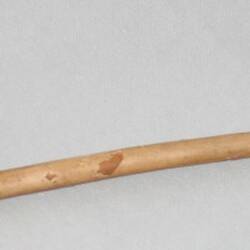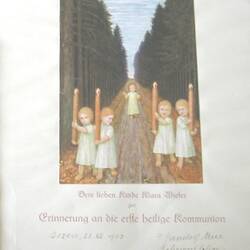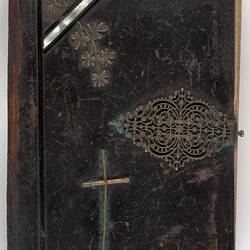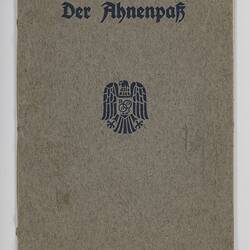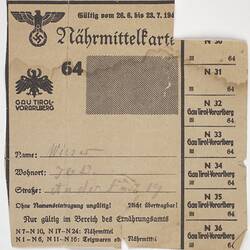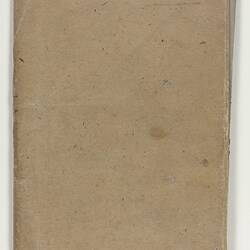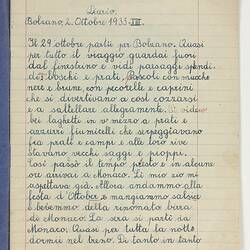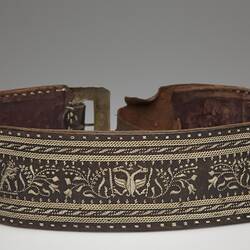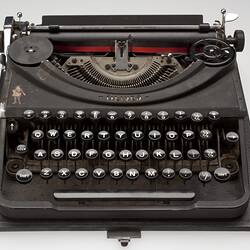Heinrich Maria Wieser was born to a staunch Catholic family in South Tyrol on 28 January 1895. His future wife Georgina Flugel was born to a staunch Lutheran family, who were described as being Franconians first, Bavarians second and Germans last, in Bayreuth Germany on 3 December 1900. Heinrich and Georgina married in 1923 in Bozen (Bolzano), South Tyrol and spent most of their married life in Selb, a district of Beyreuth in Bavaria. Heinrich was a sculptor and designer and worked at the Rosenthal factory, known as the best china factory in Germany. During World War II the Jewish owners and all staff, including Heinrich, were removed from the factory.
Their daughter Clara (Claire) Anna Maria Margaretha was born in 1924 and their son Othmar Heinrich Jakob in 1934. When Claire was nine years old her father insisted she learn Italian so she could inherit the family property in South Tyrol. She attended convent school in Italy for four years and completed her education in Germany in 1942. It was difficult for women to attend university under Hitler's regime, and various entrance courses were set to reduce the number of women enrolled. However Claire managed to attend Innsbruck University from 1943-44, studying International Law and Political Science. The university closed in 1944 and Claire was selected by the Gestapo, who were looking for Italian speakers, to work for the War Tribunal in Italy (set up to prosecute Italian partisans). Through the assistance of a professor at Innsbruck University she secured an Italian teaching job in Reutte and managed to avoid working for the Gestapo, much to her and her family's relief.
By this time the family were struggling, Heinrich had lost his Rosenthal job and was considered a Jewish sympathiser and their property was had been seized because they were South Tyrolean. At this time Heinrich was working as a technician for the South Tyrolean government in Innsbruck, where they lived untill 1951. After the War Claire returned to Innsbruck University and, as an English speaker, was requested to work as a translator for the American and then French military governments who occupied Austria. The citizenship of her family was undecided: Italian before the war, it was now unclear whether they were German or Italian. Their situation was desperate as the family struggled to live on Claire's meagre wage, food was scarce, her parents ill, and they lived in straitened circumstances.
Georgina's sister (who had been a Lutheran missionary in Papua New Guinea) was now living in South Australia having spent some of the war in Tatura internment camp. She worked to get the family accepted for migration to Australia. Claire managed to secure them Italian passports, which made the family's migration possible, with German citizenship they would not have been accepted. The aunt found them a sponsor, the Habich Monumental Works, in Nuriootpa in South Australia. Heinrich, Georgina and the children arrived in Melbourne on 6 February 1951, and travelled by train to to Nuriootpa, a German settlement in South Australia. Tragically, Georgina, died of illness five months later, devastating the family. Heinrich initially worked for Habich as a stone mason (a trade he learned in his youth). He later worked for as a map maker for the Department of the Interior in Canberra, before leaving for Papua New Guinea to work for the Lutheran Mission.
Claire initially found fruit picking work in Nuriootpa, but found the town oppressive and overly controlled by the Lutheran pastors who tried to 'assist' the family. She then moved to Melbourne to work at the French Consulate, then to Bogong Village in the Kiewa Valley for six months, where she worked as a translator for the tunnel workers, leaving on account of sexual harassment by French engineers. By this time her father had moved to PNG, where he built a church at Mumeng (later destroyed by fire), decorated with his own wood carvings and those of the locals whom he trained. During his time in PNG Heinrich did many portraits of the locals.
While living at Bogong, Claire found that the beauty of the Victorian Alps and her growing friendship with an Australian man Jack French helped heal her grief over the loss of her mother. After six months at Bogong Claire returned to Melbourne to complete her studies at Melbourne University, in German and French, working for four years as secretary/researcher to Professor Chisholm in the French and German Department (her fees were paid to subsidise her meagre wages). Jack French was transferred by the SEC to Benalla and then to Melbourne where friendship became marriage in Sydney on 2nd April 1956. Jack's family were horrified that he was marrying a 'German', as his father had lost a leg and was still carrying shrapnel from World War II. The wedding was a grand affair, at Jack's mother's insistence, and Claire's father returned from PNG to attend. Heinrich was never able to come to terms with life in Melbourne and had never learnt English well. He returned to Innsbruck in 1958.
Claire and Jack remained in Melbourne and had a daughter, Edith Georgina in 1957, a son Henry Arthur in 1959 and another son Edward in 1964. Claire's brother had finally settled in Sydney having been a captain in the Australian Army but died suddenly in 1976. Claire remained in Melbourne, however her youngest son Edward chose to migrate to England in 1985, where his paternal grandfather had originated. He works as an artist and designer like his paternal grandfather.
More Information
-
Keywords
immigration, World War I, Cultures and histories : Melbourne and Victoria
-
Authors
-
Article types

